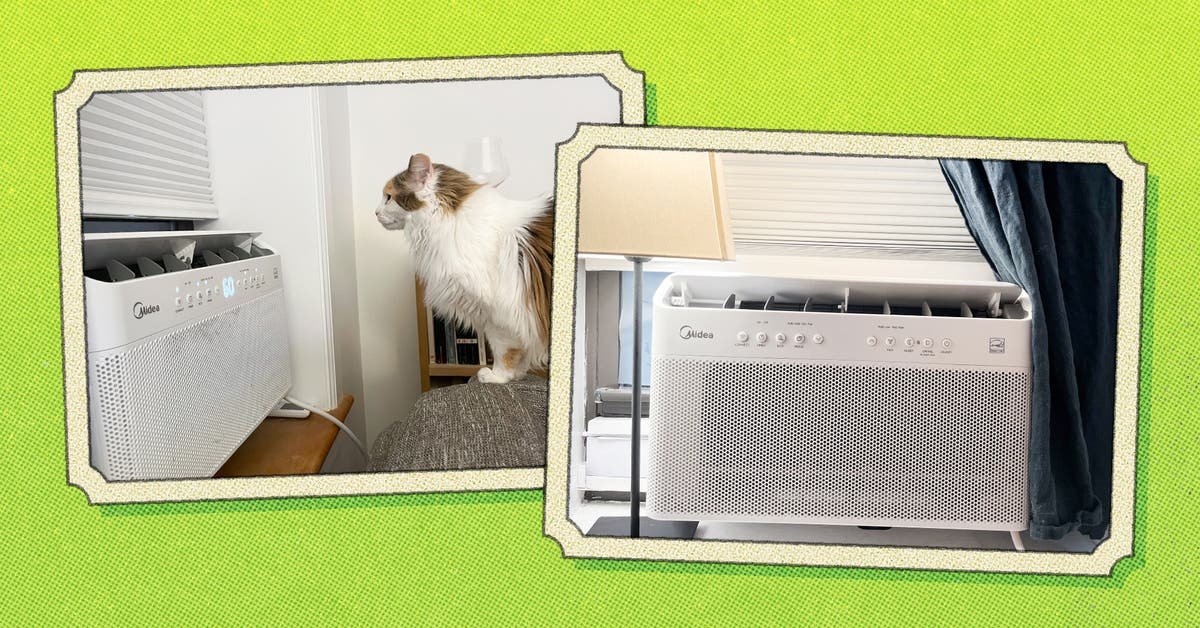
Some owners have reported issues with a high-pitched squeal coming from the machine, and others have noticed mold growing inside the unit. I have not had either of those problems.
But the installation process nearly broke my spirit.
Thom—who has tested dozens of AC units over the years, including multiple versions of Midea’s U-shaped AC across five different houses—writes in our air conditioner guide that “the installation process is a special kind of hell.” I found that assessment to be a tremendous understatement.
Wielding any window AC is never an easy task, especially if you take yours in and out seasonally. But while you can fit a typical AC unit into place in a stressful 10-minute push culminating in a small prayer whispered as you sandwich the machine into the window frame, installing the Midea U is an even bigger ordeal.
Compared with other ACs, the Midea U’s design relies more heavily on a support bracket, such that pressure from the window frame is not as integral to keeping the unit in place. The bracket also needs to be installed at an angle—just slightly less than level—so that water can drain out of the back of the unit. Otherwise, you risk the pooling water and mold that so many Reddit comments warn about. And if you don’t (or can’t) install the bracket correctly, your unit is held in only by the window and isn’t properly seated.
The first 10 minutes of taking measurements and installing the bracket seem fine. Easy, even. Yes, you need to be a little more diligent with the measuring tape, but you’ll think to yourself, “This isn’t so bad, right? It can’t possibly be as bad as that Wirecutter guide and all those online reviews say it will be.”
Do not be fooled. It will get worse. It will get so bad that you will question your intelligence, your ability to follow directions, your resolve, and your commitment to keeping this new AC unit. In a moment of despair, you will call Costco to inquire about the return policy (it’s very generous).
As I learned over the next four hours, the Midea U’s bracket is a particularly poor fit for pre-war New York City apartment windows like mine. Many of these windows have a stone frame with a ledge just wide enough to prevent the bracket’s feet from touching the side of the building exterior, making it impossible to fit the unit at anything less than an extreme slope in either direction. The shape of the bracket also means that installation requires dangling out of a window just a little farther than I’m comfortable with.
What I thought would take an hour became a whole afternoon spent in a non-air-conditioned room futzing around with the bracket, staring at it in disbelief, getting angry, and, in my frustration, accidentally dropping multiple tools and bits and bobs out of the window into the (fortunately inaccessible) corridor between my building and the next. Midea includes extra pins for the bracket, which tells me that I’m not the first person to send things falling out a window during installation.
Eventually, I decided to attach a spare 0.75-inch-thick piece of pine board to the base of the bracket’s feet, giving it enough additional length to meet the building’s exterior at the correct angle. Walking around the city, I occasionally spot similarly jury-rigged Midea U units, sometimes with a brick or even a book raising the AC (see above).
It gets easier. I was able to install my second unit in about 45 minutes. And I imagine that if you live in a house or an apartment building that was not erected over a century ago with a design quirk, the process will be significantly easier and less discouraging.
Having been through it, would I do it all over again?
Without hesitation. I have to strain to think back to that humid afternoon. No sooner had I turned on the AC that day than I began to forget what all the fuss had been about. Since that day I’ve had a year of quiet, uninterrupted sleep and cool breezes.
And then there’s my favorite thing about it: My cat seems to love it as much as I do. As soon as I turn it on, she’ll bound across the room and stick her face in front of the vent, sniffing the cold air with her fur rustling in the artificial breeze.
This article was edited by Catherine Kast and Megan Beauchamp.





